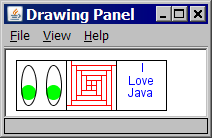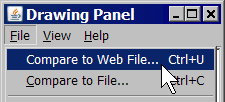University of Washington, CSE 142
Lab 3: Parameters, Graphics
Except where otherwise noted, the contents of this document are Copyright 2013 Stuart Reges and Marty Stepp.
lab document created by Marty Stepp, Stuart Reges and Whitaker Brand
Basic lab instructions
- Mouse over highlighted words if you're not sure what they mean!
- Talk to your classmates for help.
- You may want to bring your textbook to future labs to look up syntax and examples.
- Stuck? Confused? Have a question? Ask a TA for help, or look at the book or past lecture slides.
- Complete as much of the lab as you can within the allotted time. You don't need to keep working on these exercises after you leave.
- Feel free to complete problems in any order.
- Make sure you've signed in on the sign-in sheet before you leave!
Today's lab
Goals for today:
- gain a better understanding of how scope works
- learn the basics of declaring and passing parameters to methods
- learn to set a breakpoint with the jGRASP debugger to find out what is going on inside a program
-
use the instructor-provided
DrawingPaneland Java'sGraphicsandColorclasses
Scope
Scope: a variable's scope is the part of a program in which it exists. In Java, the scope of a variable starts where it is declared and ends when the closing curly brace for the block that contains it is reached.
1 2 3 4 5 6 7 8 |
public static void main(String[] args) {
int x = 5;
for (int i = 1; i <= 5; i++) {
int y = 10;
System.out.println(x) // x is still in scope here!
}
System.out.println(x) // x is still in scope here, too!
}
|
xis in scope between its declaration online 2, and the curly brace that encloses it online 8.yis in scope between its declaration online 4and the curly brace that encloses it online 6.- Loop variables are in scope between their
forloop's { }. So,iis in scope betweenlines 3 - 6.
Note: Two variables with the same name cannot both exist within the same scope.
Exercise : Scoping 1
What does the following code print out?
1 2 3 4 5 6 7 8 |
public static void main(String[] args) {
mystery();
}
public static void mystery() {
int x = 50;
System.out.println(x);
}
|
Output 50 |
Exercise : Scoping 2
What does the following code print out?
1 2 3 4 5 6 7 8 9 |
public static void main(String[] args) {
int x = 15;
mystery();
}
public static void mystery() {
int x = 50;
System.out.println(x);
}
|
Output 50 |
Exercise : Scoping 3
What does the following code print out?
1 2 3 4 5 6 7 8 9 10 11 |
public static void main(String[] args) {
int x = 15;
mystery();
System.out.println(x);
}
public static void mystery() {
int x = 50;
x = x + 5;
System.out.println(x);
}
|
Output 55 15 |
Parameters
A parameter allows you to pass in a value (an expression or a variable!) to a method as you call it.
Example:
1 2 3 4 5 6 7 8 9 10 11 12 13 |
public static void main(String[] args) {
squared(3); // 3 times 3 is 9
squared(8); // 8 times 8 is 64
int x = 5;
squared(x); // 5 times 5 is 25
squared(2 + 2) // 4 times 4 is 16
}
public static void squared(int num) {
System.out.println(num + " times " + num + " is " + (num * num));
}
|
Exercise : Parameters 1
What does the following code print out?
1 2 3 4 5 6 7 8 |
public static void main(String[] args) {
int x = 15;
mystery(x);
}
public static void mystery(int y) {
System.out.println(y);
}
|
Output 15 |
Exercise : Parameters 2
What does the following code print out?
1 2 3 4 5 6 7 8 9 |
public static void main(String[] args) {
int x = 15;
int y = 20;
mystery(x);
}
public static void mystery(int y) {
System.out.println(y);
}
|
Output 15 |
Value Semantics
When passing around ints, doubles, chars, or Strings, we need to consider value semantics.
1 2 3 4 5 |
public static void main(String[] args) {
int x = 5;
int y = x;
x = 10; // note that y still = 5. It does not change values as x changes.
}
|
continued on next slide...
Value Semantics (continued)
This concept persists within parameters. For example:
1 2 3 4 5 6 7 8 9 |
public static void main(String[] args) {
int x = 5;
mystery(x);
// x still equals 5.
}
public static void mystery(int x) {
x = x + 5; // the value of x in mystery is now 10. main's x is unchanged.
}
|
Exercise : Parameters 3
What does the following code print out?
1 2 3 4 5 6 7 8 9 10 |
public static void main(String[] args) {
int x = 15;
mystery(x);
System.out.println(x);
}
public static void mystery(int x) {
x = x + 50;
System.out.println(x);
}
|
Output 65 15 |
Parameter Ordering
When passing multiple parameters, order matters. For example:
1 2 3 4 5 6 7 8 9 |
|
Exercise : String Parameters 1
What does the following code print out?
1 2 3 4 5 6 7 8 |
public static void main(String[] args) {
String x = "y";
mystery(x);
}
public static void mystery(String x) {
System.out.println(x);
}
|
Output y |
Exercise : String Parameters 2
What does the following code print out?
1 2 3 4 5 6 7 8 9 10 |
public static void main(String[] args) {
String x = "y";
mystery(x);
mystery("x");
mystery("y");
}
public static void mystery(String x) {
System.out.println(x);
}
|
Output y x y |
Note: this is a simplified version of a type of problem called a Parameter Mystery! A parameter mystery is guaranteed to show up on the midterm. There are practice parameter mysteries of midterm-level difficulty later in this slide deck, in this week's section handout, and on PracticeIt!
Graphics
Now we'll explore several exercises related to drawing graphics. (none)


-
We'll use a provided class
DrawingPanelthat works with Java classesGraphics(a "pen" for drawing) andColor. -
Download
DrawingPanel.javaby right-clicking the link and selecting "save as". -
You can't open DrawingPanel by clicking on an icon. But if you make a DrawingPanel in Java (which we'll do soon!), a panel will open in a pop-up! You can interact with this window with your mouse, and can check the correctness of your drawings in
DrawingPanelby clicking File, Compare to Web File....
Checkpoint: Congratulations!
Nice job making it this far--labs are tough! Feel free to work with the person next to you for the remaining slides. Labs are a unique opportunity (unlike homework) to collaborate directly on ideas, and practice peer programming.
These next problems get a little more challenging as we explore earlier concepts further.
We put a lot of problems in here so that you have plenty to refer back to later when working on homework. Don't feel bad if you don't finish all of them--Brett can't finish them all in a 50 minute lab, either! :)

Forest the cat says good job!
Parameterized methods and Graphics
When you want to divide a graphical program into multiple drawing methods, you must pass Graphics g as a parameter in addition to any other parameters. Example:
1 2 3 4 5 6 7 8 9 10 11 |
public static void main(String[] args) {
DrawingPanel panel = new DrawingPanel(400, 300);
Graphics g = panel.getGraphics();
...
drawStuff(g, 13, 52, 7);
}
public static void drawStuff(Graphics g, int a, int b, int c) {
g.drawLine(a, 45, b, c);
...
}
|
If you finish them all...
If you finish all the exercises, try out our Practice-It web tool. It lets you solve Java problems from our Building Java Programs textbook.
You can view an exercise, type a solution, and submit it to see if you have solved it correctly.
Choose some problems from the book and try to solve them!